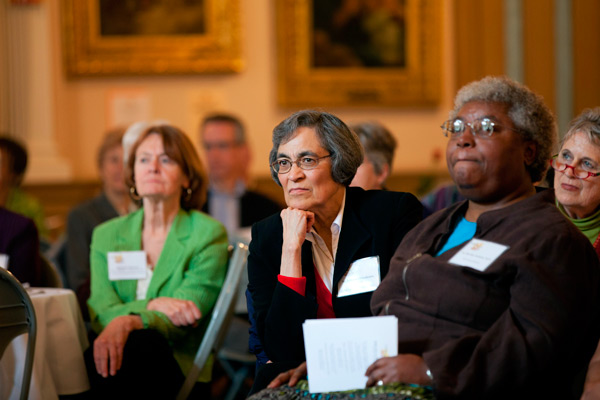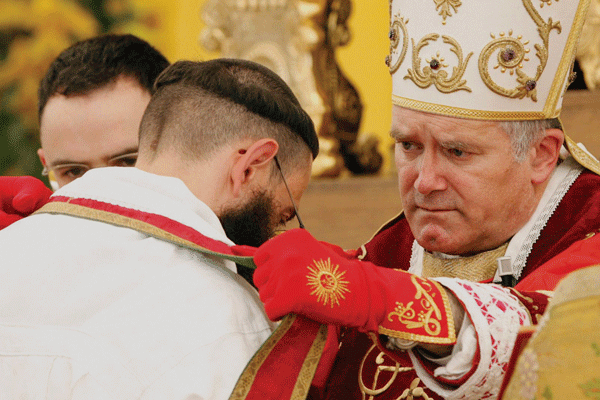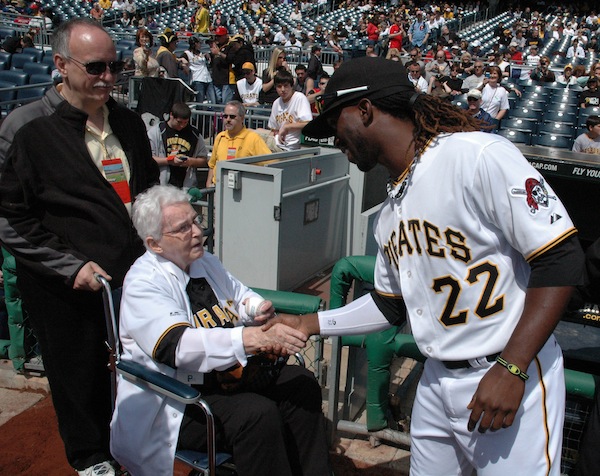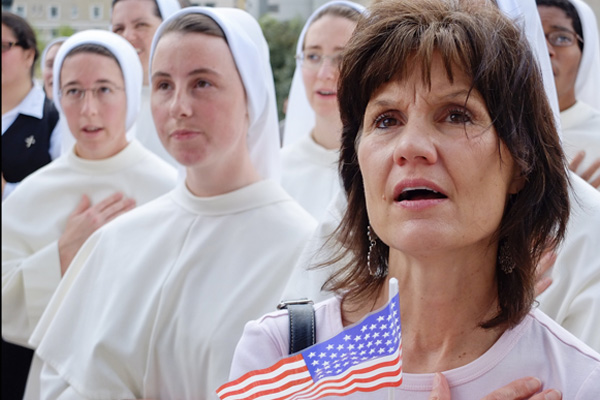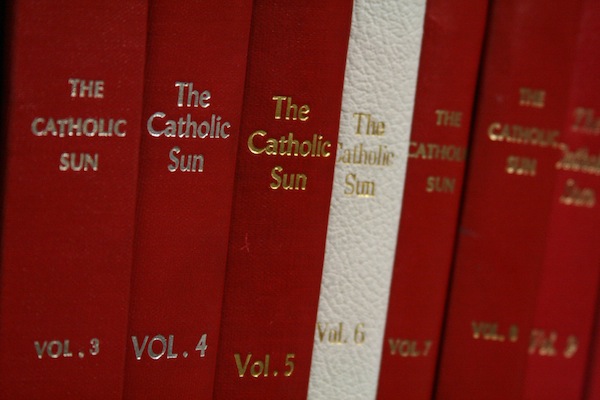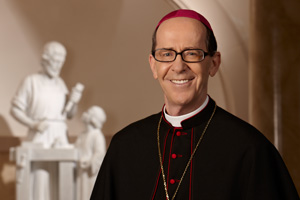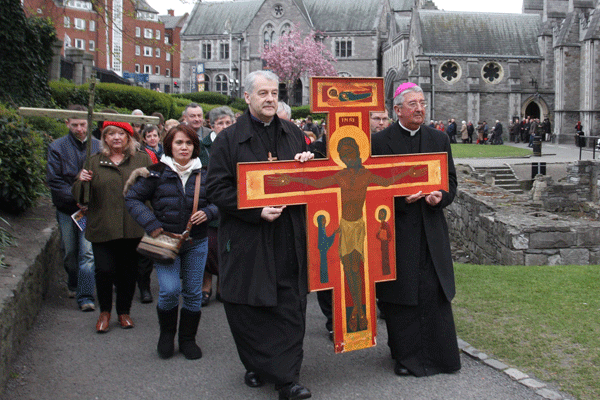
INDIANAPOLIS (CNS) — The journey to full communion in the Catholic Church “has taken a few twists and turns,” said a former Anglican priest who joined the church with his community during the Easter Vigil in Indianapolis.
“But once you get to your destination, it seems so natural,” Luke Reese said.
History was made at SS. Peter and Paul Cathedral April 7 when 17 Anglicans, all members of the St. Joseph of Arimathea Society in Indianapolis, became Catholics according to rules established by Pope Benedict XVI in his 2009 apostolic constitution “Anglicanorum coetibus.”
The document provided a way for entire Anglican parishes or groups to become Catholic while retaining some of their Anglican heritage and liturgical practice.
Earlier this year, Pope Benedict approved the establishment of the new U.S. Ordinariate of the Chair of St. Peter, based in Houston, which functions like a diocese for former Anglicans in the United States and Canada.
In Indianapolis, the Anglicans were welcomed in the church by Bishop Christopher J. Coyne, apostolic administrator of the archdiocese. They are the fourth group of former Anglicans to join the ordinariate.
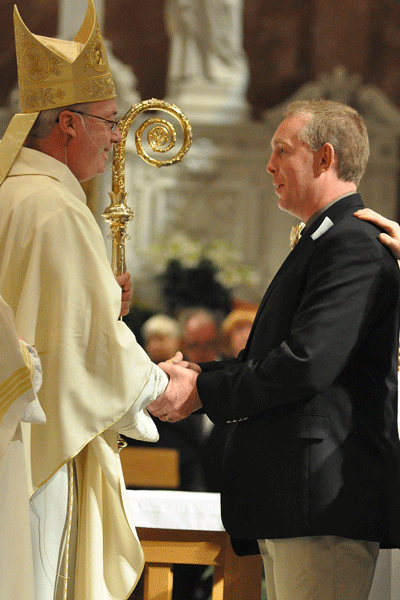
“It’s glorious. I’m happy. I’m satisfied,” said Reese, leader of the society who is a husband and father of six children. He is in formation to be ordained a Catholic priest in the ordinariate.
Bishop Coyne was happy to play a role in this historic event.
“It was definitely an honor to welcome the families of the new Anglican communion here in Indianapolis,” he said. “I look forward to continuing to help them become a rich part of our local Catholic community.”
Father Stephen Giannini, archdiocesan vicar for clergy, parish life coordinators, formation and personnel, served as a liaison between the Anglicans and the church as they sought to become Catholics.
“It has been a privilege to assist the Anglican families who became members of the Catholic Church during this year’s Easter Vigil,” he said. “We look forward to continuing our support for these faithful Christians. It is truly a blessing for us all as together our faith is deepened by Christ’s peace in the Catholic Church.”
In comments sent to The Criterion, the newspaper of the Indianapolis Archdiocese, Msgr. Jeffrey Steenson, leader of the ordinariate and formerly a bishop in the Episcopal Church, offered his support to the new members.
“I am praying for Luke and his people,” he said. “It takes much courage and faith to make this journey, to leave familiar things behind. But almost everyone I know who has come into full communion describes it as a coming home experience. If this community focuses on the joy of being Catholic, they will grow and prosper in the Holy Spirit.”
Reese said that his group coming into the Catholic Church, which he described as “the powerhouse,” may very well lead to many more people joining in the future.
“But it’s all up to God,” said Reese, 43. “We’re going to be content with whatever God gives us.”
Currently, the group gathers at Our Lady of the Most Holy Rosary Church in Indianapolis on Sunday mornings to pray Morning Prayer, according to the Anglican tradition, then attend the parish’s 9:30 a.m. Mass.
Although that parish is not part of the ordinariate, the new Catholics are happy to worship in a community much larger than their previous one.
“For a long time, we’ve been very isolated,” said Gina Reese, 43, who is Luke’s wife. “We felt like we were on a desert island. Finally, we’re coming into the fullness of the faith and into a larger community. For me, that represents a lot of hope and excitement and joy.”
Luke Reese said that, starting last fall, the group studied the Catechism of the Catholic Church and the United States Catholic Catechism for Adults in preparation for being received into the church.
He and Gina met when they were music students at Butler University in Indianapolis during the 1980s and 1990s. They learned about the Anglican spiritual tradition when Luke became a paid member of a choir at an Episcopal parish in Indianapolis.
“We fell in love with the liturgical form of worship,” Luke Reese said. “It’s absolutely stunning. The worship is just so beautiful.”
About 10 years ago, he was ordained as an Anglican priest and ministered within the Traditional Anglican Communion, a worldwide group of several hundred thousand Anglicans that separated themselves from the Anglican Communion led by the archbishop of Canterbury.
He and his small group desired to come into the full communion with the Catholic Church before Pope Benedict issued “Anglicanorum coetibus,” in part because of their dissatisfaction about a continuing trend of schism among Anglicans.
“Schism really is a sign of internal problems,” Luke Reese said. “And there’s been schism after schism after schism. We were just fed up with it.”
– – –
Gallagher is a reporter at The Criterion in Indianapolis.



